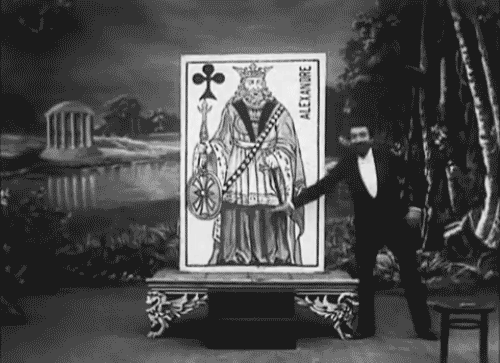August 3, 1904 [Les Cartes vivantes/The Living Playing Cards]
Méliès the magician, combining a serviceable stage routine with more-than-decorative camera effects (and along the way alluding to Alice in Wonderland). The tiny card-deck grows larger and larger, several feet high—eventually of course life-sized—and more: alive, the Queen first, parading on the stage. And so it seems Méliès has achieved his goal, artifice becoming reality, albeit stage-bound.
But then the King, too, is animated, and something typically unbalancing occurs: he frightens Méliès, driving the magician from his stage. Is this some farcical Frankenstein inversion, the creator supplanted by the creature, which becomes the central figure of the piece?
But one more transformation, the true climax: the King becomes Méliès. I returned to watch again, and the effect is arresting. Méliès bounds off the stage, I see no camera-frame jump or other jarring changes in the scene itself, and Méliès returns, his multiple roles reconciled: the one who generates the idea, brings it to the film, performs as the magician, becomes the trick. Méliès presents a perfect metaphor for the film-maker: an illusionist who becomes the illusion. He bends the camera to his will, as though Edison's Sandow the Strong Man has left the frame and made his way behind the camera, ready to bring welcome mayhem to the story of the cinema—and in so doing controls the experience at every stage, even as it enters our imagination.
But then the King, too, is animated, and something typically unbalancing occurs: he frightens Méliès, driving the magician from his stage. Is this some farcical Frankenstein inversion, the creator supplanted by the creature, which becomes the central figure of the piece?
But one more transformation, the true climax: the King becomes Méliès. I returned to watch again, and the effect is arresting. Méliès bounds off the stage, I see no camera-frame jump or other jarring changes in the scene itself, and Méliès returns, his multiple roles reconciled: the one who generates the idea, brings it to the film, performs as the magician, becomes the trick. Méliès presents a perfect metaphor for the film-maker: an illusionist who becomes the illusion. He bends the camera to his will, as though Edison's Sandow the Strong Man has left the frame and made his way behind the camera, ready to bring welcome mayhem to the story of the cinema—and in so doing controls the experience at every stage, even as it enters our imagination.



Comments
Post a Comment